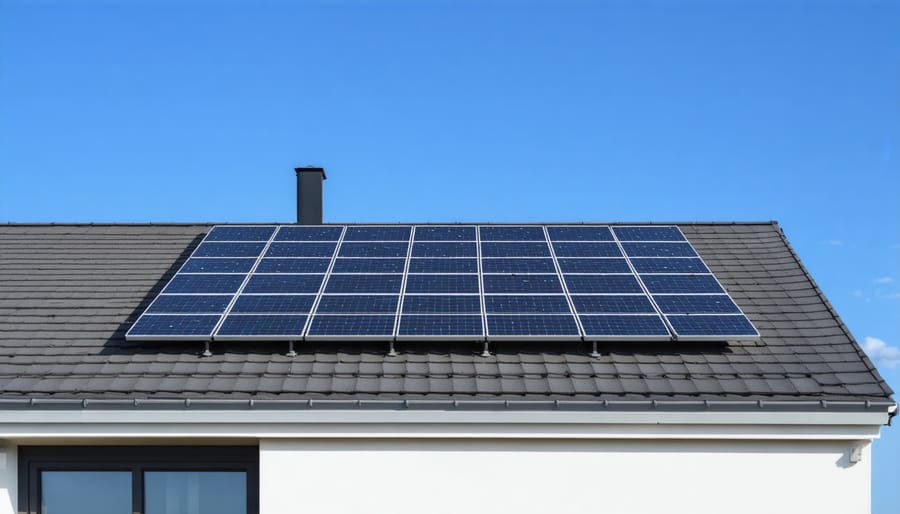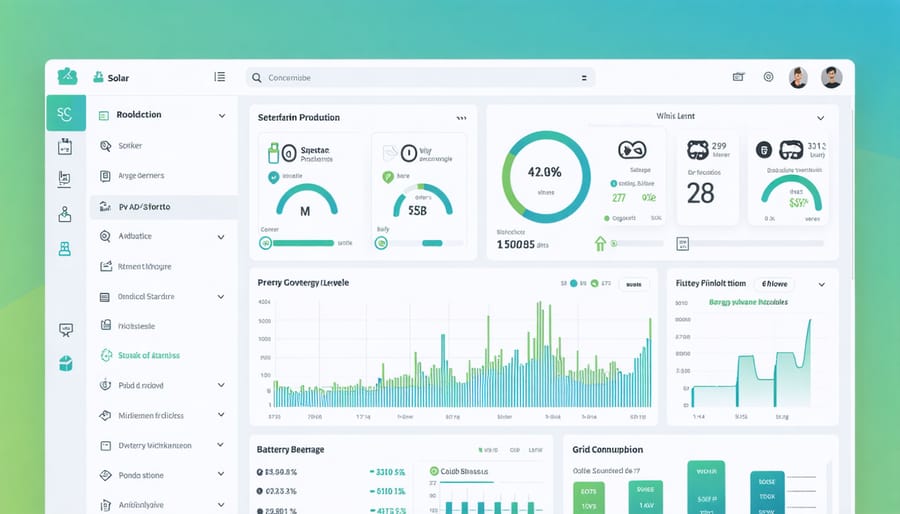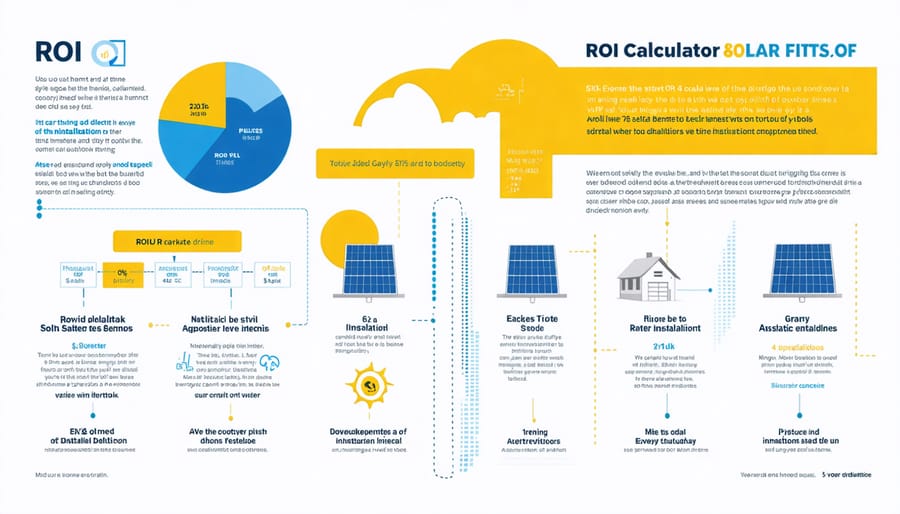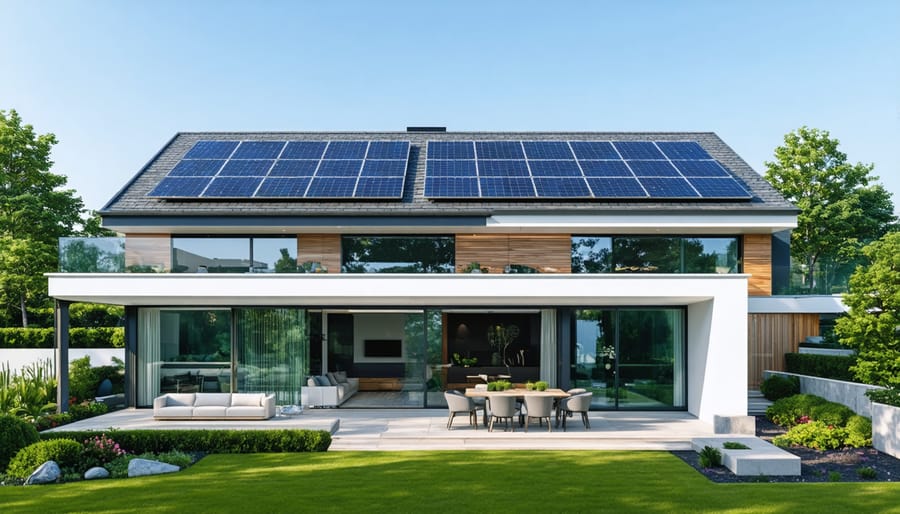Transform your home’s energy landscape by integrating renewable systems strategically, starting with a comprehensive eco-friendly home transformation. Begin with a professional energy audit to identify optimal placement for solar panels, wind turbines, or geothermal systems based on your property’s unique characteristics. Smart energy management systems connect seamlessly with existing home infrastructure, automatically balancing power consumption between renewable sources and the grid while maximizing efficiency.
The transition to renewable energy represents more than just environmental responsibility—it’s a practical solution to rising energy costs and grid independence. Modern integration technologies have simplified the process, making it possible for homeowners to generate, store, and manage their own clean energy while maintaining reliable power supply. Whether you’re considering a complete solar installation or starting with smaller renewable components, today’s plug-and-play systems offer unprecedented flexibility and control over your home’s energy future.
By understanding the fundamental components of renewable integration—generation, storage, and smart distribution—homeowners can make informed decisions about which systems best suit their needs and budget. The key lies in choosing scalable solutions that can grow with your energy requirements while providing immediate benefits in terms of reduced utility bills and increased home value.
Understanding Residential Renewable Energy Systems
Solar Power: The Cornerstone of Home Energy
At the heart of modern sustainable home solutions, solar power systems have become increasingly accessible and efficient. A typical residential solar setup consists of several key components working together seamlessly. The solar panels, typically mounted on your roof, capture sunlight and convert it into electricity through photovoltaic cells. These panels connect to an inverter, which transforms the direct current (DC) into alternating current (AC) that your home can use.
The system also includes a meter to track energy production and consumption, while mounting hardware keeps everything securely in place. Many homeowners opt to include battery storage, allowing you to store excess energy for use during cloudy days or nighttime. Modern systems also come with smart monitoring capabilities, letting you track performance right from your phone.
What makes residential solar particularly appealing is its scalability – you can start with a few panels and expand as needed. The panels themselves have become more aesthetically pleasing, with sleek designs that complement various architectural styles. Plus, with improved efficiency ratings, you need fewer panels to power your home compared to systems from just a few years ago.
When planning your solar installation, consider factors like roof orientation, local weather patterns, and your household’s energy needs. Most systems are designed to last 25-30 years, making them a long-term investment in your home’s future.

Beyond Solar: Wind and Geothermal Options
While solar panels often steal the spotlight, wind and geothermal energy systems offer exciting alternatives for eco-conscious homeowners. Small-scale wind turbines can be a fantastic option if you have enough space and live in an area with consistent wind patterns. These systems typically need at least half an acre of land and average wind speeds of 10-12 mph to be effective.
Geothermal heating and cooling systems, though less visible than both solar panels and wind turbines, pack a powerful punch in energy efficiency. By tapping into the earth’s constant underground temperature, these systems can heat and cool your home while using up to 70% less energy than traditional HVAC systems.
Before jumping into either option, consider your local climate, property size, and zoning laws. Wind turbines work best in rural or suburban areas with few obstacles, while geothermal systems can be installed almost anywhere but require significant excavation during installation. Both options typically cost more upfront than solar panels but can offer excellent long-term savings and reliability.
Remember to consult with local renewable energy contractors who can assess your property’s specific potential for these alternative energy sources.
Smart Integration Strategies
Energy Storage Solutions
Energy storage is a crucial piece of the renewable energy puzzle, especially for homeowners looking to maximize their system’s efficiency. Think of storage solutions as your energy savings account – they store excess power generated during sunny or windy periods for use when you need it most.
The most popular storage option for homes is lithium-ion battery systems, similar to what you might find in your electric devices but scaled up significantly. These batteries are becoming more affordable each year and can power your home for several hours during outages or cloudy days. Many homeowners start with a single battery unit and expand their storage capacity over time as needed.
Other storage options include lead-acid batteries, which are less expensive but require more maintenance, and flow batteries, which are excellent for longer-term storage needs. For those interested in a more budget-friendly approach, thermal storage systems can store excess solar energy as heat in water tanks or specialized materials.
When choosing your storage solution, consider these key factors:
– Daily energy usage patterns
– Available space for installation
– Climate conditions in your area
– Budget constraints
– Backup power needs
Remember that proper sizing is essential – too small a system won’t meet your needs, while oversizing can lead to unnecessary expenses. Many local installers offer free consultations to help you determine the right storage capacity for your home.
Smart Home Energy Management
Today’s smart home technology makes monitoring and managing your renewable energy system easier than ever. With intuitive apps and automated controls, you can manage energy consumption efficiently while maximizing the benefits of your renewable energy setup.
Modern energy management systems connect seamlessly with your solar panels, battery storage, and home appliances. Through user-friendly dashboards, you can track real-time energy production and usage, helping you make informed decisions about when to run energy-intensive appliances or store power for later use.
Smart thermostats learn your preferences and automatically adjust heating and cooling based on solar production peaks. Motion sensors ensure lights are only on when needed, while smart plugs can power down devices during low-production periods. These automated features work together to optimize your home’s energy flow without requiring constant attention.
The best part? You can control everything from your smartphone. Whether you’re at work or on vacation, you’ll have complete visibility into your home’s energy status. Set up custom alerts to notify you about production dips or consumption spikes, and adjust settings remotely to maintain optimal efficiency.
For those just starting out, many systems offer guided setup processes and pre-configured modes that make implementation a breeze. As you become more familiar with your usage patterns, you can fine-tune the automation to match your lifestyle perfectly.

Grid Connection and Net Metering
Connecting your renewable energy system to the power grid is like having a backup plan that works both ways. When your system produces more energy than you need, that excess power flows into the grid, and when you need more power than your system generates, you can draw from the grid seamlessly.
Net metering is the real game-changer here. Think of it as a two-way street where your electric meter runs backward when you’re contributing power to the grid. This means you get credit for the excess energy your system produces, which can significantly reduce your monthly utility bills. In many areas, you’ll only pay for the “net” amount of electricity you use.
To get started with grid connection, you’ll need to work with a certified electrician and your local utility company. They’ll help ensure your system meets all safety requirements and local regulations. Most utilities require a special interconnection agreement and may need to inspect your system before giving the final approval.
The benefits of grid connection are substantial:
– Lower electricity bills through net metering credits
– Reliable backup power when needed
– No need for expensive battery storage systems
– Potential income from selling excess power
– Increased home value
Remember to check your local utility’s specific net metering policies, as rates and terms can vary by location.
Cost Considerations and ROI
Initial Investment and Installation
When considering renewable energy for your home, understanding the initial investment is crucial for making an informed decision. Most residential solar installations typically range from $15,000 to $25,000 before incentives, while small wind turbine systems generally cost between $8,000 and $32,000 depending on size and placement requirements.
The good news is that various federal, state, and local incentives can significantly reduce these costs. The federal solar tax credit, for example, allows you to deduct 30% of your installation costs from your taxes. Many utility companies also offer additional rebates and incentives.
Installation typically takes 2-3 days for solar panels and about a week for wind systems. You’ll need to consider factors like:
– Roof condition and orientation (for solar)
– Local zoning laws and permits
– Electrical system compatibility
– Available space
– Structural support requirements
It’s worth getting multiple quotes from certified installers, as prices can vary significantly. While DIY installation might seem tempting, professional installation ensures safety, optimal performance, and maintains warranty coverage. Remember to factor in permit fees and possible structural modifications when budgeting for your renewable energy system.
Available Incentives and Tax Benefits
Ready to make the switch to renewable energy? You’ll be happy to know there are numerous financial incentives available to help offset your initial investment. The federal government offers a substantial 30% tax credit through the Residential Clean Energy Credit for solar, wind, and geothermal installations. This credit alone can save you thousands on your renewable energy system.
Many states offer additional tax incentives and rebates. For example, some provide property tax exemptions for the added home value from renewable installations, while others offer cash rebates for specific systems. Local utilities frequently provide performance-based incentives, paying you for the renewable energy your system generates.
Don’t overlook programs like net metering, which allows you to sell excess power back to the grid. Some areas also offer low-interest financing options and grants specifically for renewable energy projects. To maximize your savings, check with your state energy office and local utility company about available programs – new incentives are regularly introduced as governments push for cleaner energy adoption.
Remember to keep all documentation of your installation for tax purposes, and consider consulting with a tax professional to ensure you’re claiming all eligible benefits.
Long-term Savings Calculator
Ready to see how your renewable energy investment can pay off? Our easy-to-use savings calculator helps you make informed decisions about your green energy future. Start by entering your current monthly energy bills, local utility rates, and the size of your planned renewable system. The calculator factors in available tax incentives, rebates, and other energy-saving home improvements to give you a complete financial picture.
For solar installations, you’ll typically see a return on investment within 5-10 years, depending on your location and energy usage. Wind and geothermal systems might take longer but often provide greater long-term savings. Our calculator also considers maintenance costs and system degradation rates to give you realistic expectations.
Don’t forget to update the calculator periodically as utility rates change and new incentives become available. You can also adjust the parameters to explore different system sizes or compare multiple renewable options. This helps you find the sweet spot between initial investment and long-term savings, making your transition to renewable energy both environmentally and financially rewarding.

Maintenance and Upkeep
Regular Maintenance Schedule
To keep your renewable energy system running smoothly, follow this simple maintenance timeline:
Monthly:
• Clean solar panels with water and a soft brush
• Check battery connections and fluid levels
• Monitor system performance through your digital dashboard
• Clear debris from wind turbines if installed
Quarterly:
• Inspect all wiring connections
• Test backup systems
• Clean inverter cooling fans
• Check mounting hardware for tightness
Annually:
• Schedule professional inspection
• Update monitoring software
• Test emergency shutdown systems
• Replace any worn weatherproofing
• Calibrate sensors and meters
Every 5-10 Years:
• Replace inverter (if needed)
• Update battery systems
• Evaluate system efficiency
• Consider technology upgrades
Pro tip: Keep a maintenance log and set calendar reminders for each task. Many modern systems come with smartphone apps that help track maintenance schedules and system performance. Consider scheduling professional check-ups during spring or fall when weather conditions are mild.
Troubleshooting Common Issues
When your renewable energy system isn’t performing optimally, start with the basics: check your monitoring system for error codes and ensure all connections are secure. For solar panels, regular cleaning and debris removal often resolve reduced output issues. If your battery storage system shows unusual discharge patterns, verify your usage settings and ensure proper ventilation around the unit.
However, some issues require professional attention. Call an expert immediately if you notice:
– Electrical problems like flickering lights or circuit breaker trips
– Unusual noises from inverters or battery systems
– Significant drops in energy production without obvious causes
– Warning lights or error messages you can’t resolve
– Physical damage to any system components
For grid-tied systems, coordinate with both your installer and utility company when experiencing integration issues. Keep your system’s manual and warranty information handy, and maintain a log of any problems you encounter. This documentation helps technicians diagnose issues more efficiently and can be valuable for warranty claims.
Remember, while DIY maintenance is great for basic upkeep, always prioritize safety and don’t hesitate to contact professionals for complex problems.
As we’ve explored throughout this guide, integrating renewable energy into your home isn’t just about being environmentally conscious – it’s about creating a more sustainable and cost-effective living space for you and your family. From solar panels to smart energy management systems, the options available today make it easier than ever to embrace clean energy solutions.
Remember, every small step counts. Whether you’re starting with a simple solar water heater or planning a complete home energy makeover, your choices contribute to a greener future while potentially saving you money in the long run. Consider beginning with an energy audit to identify the best renewable solutions for your specific needs and budget.
Don’t feel overwhelmed by the process. Local contractors, government incentives, and supportive communities are available to help you navigate your renewable energy journey. Start small, plan carefully, and expand your system as your comfort and knowledge grow.
Ready to take the first step? Contact local renewable energy installers for consultations, research available incentives in your area, and join community groups focused on sustainable living. Your journey toward energy independence starts today!





